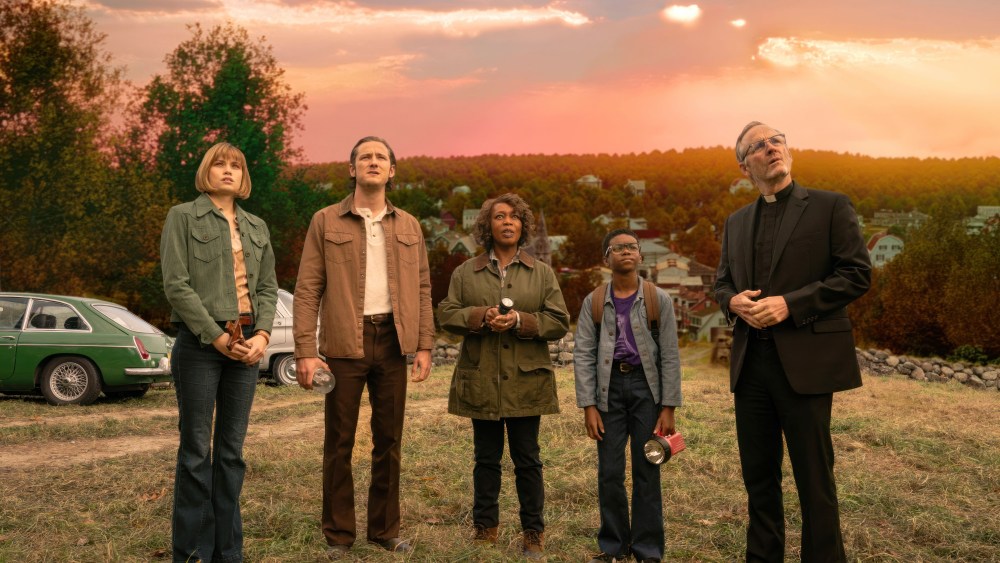Stephen King’s Mediocre Vampire Do-Over
Long before “True Blood” or “Twilight” brought vampires to small-town America, horror writer Stephen King imagined the creatures invading his backyard in rural Maine (technically, a fictional place called Jerusalem’s Lot). Until then, blood-sucking bat-men were something only Europeans had to worry about, as Dracula and his castle-dwelling kin preyed on hapless villagers half a world away. Then came “’Salem’s Lot,” King’s second novel in which the man who’d made witches a modern-day concern with “Carrie” asked American readers: What if an outbreak of vampirism struck your community?
A tepid new (technically, two years delayed) feature version returns to that question a half-century later, offering flashes of style and a more satisfying finale in an otherwise weak take on its dated source material. Whereas King seemed to be kicking another stuffy old genre into the present, writer-director Gary Dauberman’s retro-minded adaptation goes in the opposite direction, embracing the pageboy haircuts, polyester-blend duds and don’t-trust-anyone paranoia of that era.
The film takes place in 1975, the same year “’Salem’s Lot” was published. You can guestimate the period from the movie titles posted on the local drive-in theater marquee — “The Drowning Pool” and “Night Moves” — and the classic Gordon Lightfoot ditty, whose lyrics now serve as a nocturnal warning: “Sundown, you better take care/If I find you been creeping ’round my back stairs.” Trouble is, vampire lore has evolved so much in the intervening decades that Dauberman’s take comes across quaint and not nearly as scary as the earlier Tobe Hooper-made miniseries (better to pretend the 2004 stab didn’t happen).
I haven’t seen Robert Eggers’ “Nosferatu” yet, but I suspect even that silent-movie remake won’t feel as oldfangled as “’Salem’s Lot,” in which the characters turn to comic books for instructions on how to ward off the undead: using holy water and crosses, which shine white in their presence. These days, the sight of someone repelling a vampire with a crucifix made of taped-together tongue depressors seems silly, whereas I’ve heard stories of kids who caught “’Salem’s Lot” on TV carrying popsicle sticks for that same purpose.
Incidentally, the main vampire here, a bald-headed coffin-dweller named Kurt Barlow (Alexander Ward), harkens back to Count Orlok of “Nosferatu,” far more than he does old Dracula. That’s one clue that this is essentially an update of the miniseries, not a return to the source, where King clearly had Bram Stoker’s sophisticated shape-shifter in mind. An even clearer sign is the familiar silhouette of the Marsten House, the Victorian-style murder mansion acquired by Barlow’s assistant, Richard Straker (Pilou Asbæk). It’s an iconic property from which to unleash his plan: transforming every last resident of Jerusalem’s Lot in his master’s image (i.e. to make them all vampires).
Moderately successful author Ben Mears (Lewis Pullman), who grew up in the area, returns to ’Salem’s Lot at roughly the same time Straker is setting up an antique shop downtown. Both men have skeletons in their closets, though only Straker’s are literal, as we see Barlow’s coffin being transported on his orders in the opening scene — a missed-opportunity mood-setter in which the two delivery men are never heard from again, nor are they dispatched in a remotely memorable way. They simply do the job and then disappear, since King wanted the story’s first couple victims to be kids: the Glick brothers, Ralphie (Cade Woodward) and Danny (Nicholas Crovetti).
That tilts “’Salem’s Lot” in a familiar “It”-like direction, as young boys are directly endangered by a far-more-powerful supernatural phenomenon — which makes sense, since Dauberman penned the two-part “It” reboot (plus five films in the Conjuring Universe). Except, these vampires simply aren’t very intimidating, despite a few nifty upgrades, including eyes that glow gold in the dark and a materializing-out-of-nowhere trick where the camera pans back and forth to find them looming on the roofs of local buildings.
After Danny is taken, new-to-town teen Mark Petrie (Jordan Preston Carter) swears to go after the vampires — a promise that’s both reckless and relatable. Though considerably shorter than the two TV versions, Dauberman’s film starts off clunky, as if a few scenes had been cut (for example, Mark’s parents don’t appear until Barlow kills them late in the film) in search of the right flow. Straker comes off conspicuously creepy from the start, pulling up beside Mark and the Glick boys with a flamboyant, “Greetings, young masters.”
So often in horror movies, the characters don’t know what they’re dealing with, responding to zombies or vampires as if such creatures weren’t pop-culture mainstays. Here, Mark and the school principal (Bill Camp) recognize the threat relatively quickly, fashioning wooden stakes from whatever’s handy — a chair leg, a baseball bat — and impaling their attackers on them. They enlist Ben and his librarian girlfriend (Makenzie Leigh), as well as the skeptical local doctor (Alfre Woodard, who’s all, ”This is some shit!”) and alcoholic priest (John Benjamin Hickey). Still, it’s this six against nearly the entire town, as vampirism spreads faster than the most insidious coronavirus.
Broadly speaking, Dauberman has made a by-the-book adaptation, with a few diversity-minded improvements (let’s just say, Black lives matter in this version) and a plot twist or three to keep audiences on their toes. For example, Straker exits the story early, clearing the way for a different character to become Barlow’s thrall. And then there’s the climax, back at the drive-in, where the setting sun behaves in peculiar ways. It’s gratifying to think that a huge outdoor screen, which saved movies during the pandemic, could potentially save mankind. Given the junky look of this film’s visual effects, however, it’s just as well that “’Salem’s Lot” is destined for streaming, where it joins the two miniseries in the small-screen graveyard.
“’Salem’s Lot” will stream exclusively on Max, beginning Oct. 3, 2024.


